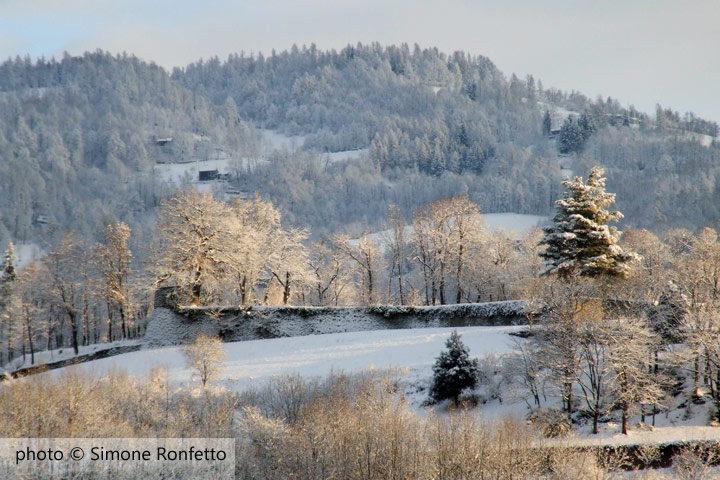Forts in Val Pellice
From the historical sites fortified to remaining traces of the Second World War
The ancient fortifications
The overall system of fortifications of Val Pellice would seem a valley bottom sluice of Langobardic or the lower Empire period, consequent to the abandonment for barbarian invasions of the Roman roads that linked Pinerolo with Cavour and Saluzzo, in favor of a connection axis between the valley bottom sluices. Langobards contended with Francs for the control of the valleys, obtaining the first the valley bottom, and the other the passes, so often the sluices system was twofold. This is witnessed by the place names of various towns and hamlets, resulting in part from the high-old German (e.g. the hamlets Eynard, Eyssart, Arnaud, etc.) and from Langobard (e.g. Rossenghi, Albertenga, etc.).
However some fortified places, such as Bricherasio, are probably even older, as evidenced by the Celtic-Ligurian name translatable into "great fortress in the mountains". It is reasonable to suppose that there was a Celtic-Ligurian fortified settlement near the current location Castelvecchio and Mutassa (even this one a significant name, reminiscent of Celtic mounds). It is noteworthy that the older fortification, among those was oval, perhaps due to a fortified camp (oppidum).
Bricherasio also had other castles and fortifications along the time, as gradually inhabitants moved from the Chiamogna Valley to current Bricherasio, according with the phenomenon of "ville nove" or "ville franche". The major part of the fortifications disappear with the war waged by Charles Emmanuel I of Savoy against the French at the end of the sixteenth century (siege of Bricherasio, 1594). In the same century it was also destroyed the fortifications of Luserna, Torre Pellice, Angrogna, Bibiana and Villar.
Going up along the valley, in the municipality of Luserna, there is the locality "Il Fortino", originally a small fort guarding the ancient bridge on the Pellice river, further a few hundred meters upstream than the current one, on the way leading to Bibiana. Currently, there is just the name left.
The town of Bibiana was defended by a Rocca (stronghold) called Castelfiore and destroyed in the sixteenth century, as already seen. Even here, however, we find a Celtic-Ligurian name, "Famolasco", where there is still a small but very ancient castle. As in the case of Bricherasio and Torre Pellice as well, the residential areas tend over time to come down from the hills on which had arisen defense fortifications, to settle further downstream, in a more fertile and convenient for commerce areas, however fortified.
Before the already mentioned wars between France and Piedmont of the sixteenth century, also Luserna was surrounded by walls with a castle on top of Monte Ombroso, later converted in Fort, called Fort of San Michele or Torrazzo, but nowadays disappeared. It was the primordial home of the family of Luserna, Counts of the valley, and divided into various branches (Manfredi, Bigliori, Rorengo). This fortress, in origin, was probably a stronghold of the Langobards sluice, and together with the castle of Torre Pellice, in visual communication with this one, allowed the control of the valleys Pellice, Luserna and Angrogna.
Torre Pellice takes precisely its name from the presence of a castle topped with a fortified tower or dungeon located on the hill now known as Collina del Forte, and again in the same location there were, over the years, different fortifications. The last of these, it was a fort with star bastion plant, called Fort of Santa Maria of Lucerna, built in 1655 and destroyed in 1690 in the war between France and the League of Augsburg, of which Vittorio Amedeo II of Savoy was part of it. Today, the visible part of the fortifications on the hill of Torre Pellice is a partial reconstruction done in 1821; the original walls are the tract toward the Valle di Angrogna.

There was also a small fort slightly above the current town of Torre Pellice, halfway up the hill, known as "Fortino della Munizione".
As for Villar Pellice, we know that was boundary wall with a watchtower. Later, a small fort was also built, known as "Pertusel". The doors of the walls are witnessed until 1889. It was also present a fortress in the town, called "Palagio Forte" - Palace of Casapiana, belonging to Rorengo. It underwent many vicissitudes during the religious wars.
Historical records and toponymy in Bobbio Pellice indicate the presence of a castle in "Ciastel" locality, probably belonging to the branch of Bigliori, even this one was destroyed in 1549. Furthermore, after Villanova hamlet, there was a fort called Fort of Mirabouc, probably built in 1565 and destroyed in 1794. Between these two dates, it underwent various vicissitudes of war and was used as a prison.
The fortifications of the modern age
Between the First and Second World War, gun emplacements were built on Colle Barant, and later destroyed in World War II.
At the end of the Second World War, the Val Pellice was also part of the Alps fortification system, known as "Alpine Wall", with the aim to prevent the invasion of Italy by the Allies. There are, therefore, bunkers, remains of retrenchment, gun emplacements and small barracks in Villar Pellice, in the area of Villanova, in the big valley of Crosenna, in Col Content, in Col Balcet and you can still see remains of fortifications in the Conca del Prà.
Article by Arch. Pierangelo Ronfetto
Bibliography
- ARMAND-HUGON A., Torre Pellice, dieci secoli di storia e di vicende, Tipografia Subalpina, Torre Pellice, 1958;
- BOLLA M., Bricherasio, territorio insediamenti e uomini nel medioevo, Tipografia Giuseppini, Pinerolo, 1980;
- PAULI L., Le Alpi: archeologia e cultura del territorio, Zanichelli, Bologna, 1983;
- PITTAVINO A., Storia di Pinerolo e del Pinerolese, Bramante Editrice, Milano, 1963;
- WICHKHAM C., L'eredità di Roma - Storia d'Europa dal 400 al 1000 d.c., Editori Laterza, Roma, 2014.

